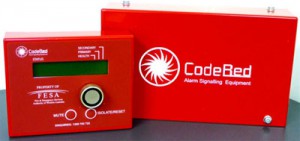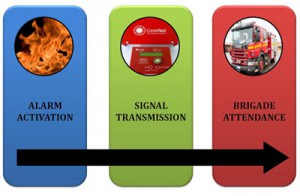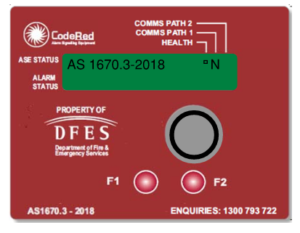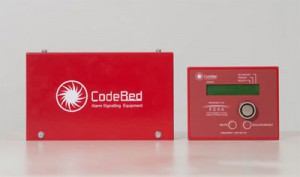Alarm Signalling Equipment (ASE)
Overview

The primary purpose of the ASE is to monitor fire alarm signals sent to the fire brigade. The Code Red Alarm Signalling Equipment (ASE) unit consists of:
- Main ASE unit (with iButton)
- LCD Display
- Antenna
The ASE is a proprietary product with the design owned by Chubb Fire & Security Pty Ltd. The ASE is only available within WA by a new connection authorisation from DFES.
Once installed at a site, the ASE remains the property of DFES and operates under warranty. This warranty protects DFES’ customers against issues arising with the ASE and ensures compliance with Australian Standards and legislative requirements. Any unit failures of the ASE or communication links are investigated by FAMS within strict SLA targets. Chargeable service calls are limited to damage to the ASE which may arise from factors beyond the control of DFES such as storm/ water damage, vandalism or interference with the ASE by third parties.
The ASE is capable of monitoring multiple signals. In addition, the ASE may be used to monitor other signals which do not call the fire brigade but can be used to alert a site of potential problems with the fire system. The ASE can monitor any of the following signals from the monitored FIP:
- Common Alarm
- Common Fault (non brigade)
- FIP/ Zone Isolate (non brigade)
- Sprinkler/ Sub Board/ Gas Alarms
- Pump Run/ Fault Secondary Alarms (non brigade)
- Water Tank Low Secondary Alarm (non brigade)
- Low Water Pressure Secondary Alarm (non brigade)
- Valve Tamper Secondary Alarm (non brigade)
- Low Battery fault (non brigade)
Communications
The ASE has an internal SIM card which it uses to communicate signals via a wireless primary link (similar to a mobile phone).

When the ASE receives a signal from the FIP relays, it is automatically transmitted to the server database at DFES. Alarm signals are automatically received at DFES ComCen for processing and appliance turnout. All other signals are routed to the FAMS monitoring centre where the Customer Service Centre (CSC) staff will call to notify the site’s nominated contacts.
The FAMS monitoring centre constantly monitor the status of all ASE units in the network. Persistent primary (wireless) link fails are investigated by a FAMS technician for remedial action. If the fault or failure has originated from the ASE, the FAMS technician will take remedial action at no charge to the client. The client will be charged a service call from DFES if a FAMS technician is requested and the fault is found on the clients’ side of the system infrastructure.
Operation as of May 2021
ASE Operation Update – Why have things changed ?
The latest version of the Australian Standard AS 1670.3-2018 Fire alarm monitoring was adopted on 1 May 2021. The previous applicable Australian Standard was AS 1670.3-2004 Fire Alarm Monitoring.
The latest version of the standard requires some changes to the Direct Brigade Alarm (DBA) Alarm Signalling Equipment (ASE) display and functionality relating to isolation of the device.
What has changed?
New DBA ASE displays will have two lines of text. “STATUS” as per previous version has now changed to “ASE STATUS” and an added “ALARM STATUS” will display ASE signal in alarm.
“ALARM STATUS” will display alarm signal number and name e,g. “SYSTEM 1 ALARM”
The isolate function has been removed and test function has been increased from 2 hours to 4 hours.
Push buttons in bottom right of panel have been changed from ‘MUTE” and “ISOLATE/RESET” to “F1” and “F2”. The “MUTE” push button has been redundant on existing ASE devices for several years.
F1 push button is spare (No Function)
F2 push button is now Reset only
Image 2- New DBA ASE & iButton (AS 1670.3 2018)
ASE Unit, Display & iButton
The ASE unit is easy to operate. Additional technical support is also provided 24/7 by the FAMS CSC.
The ASE can be toggled between 2 modes by operation of the iButton key (often referred to as a “fob”). There are 2 types of iButtons:
- Red – No longer issued to a site.
- Black – issued to individuals (technicians, wardens, facilities managers, etc).
By placing the iButton key onto the key reader of the ASE display, the user can place the ASE into one of 2 operating modes. These operating modes are:
- Normal
- Test
Offline Mode:
The ASE is only placed into Offline mode in specific circumstances.
During Offline mode, the ASE transmits data to the FAMS server and databases, but no signals are transmitted to either FAMS operators or DFES Comcen operators for action (with exception of ASE communication faults).
A site (or system) may only be placed into Offline mode by a FAMS operator. The Offline mode may only be reset by a FAMS operator and does not time out automatically after a certain period of time.
Reasons a site (or single monitored system) may be placed in Offline mode:
- New Connection – 24 hour test period
- To ensure system stability and prevent false alarms whilst building works are completed
- Standard procedure for all new DBA connections
- System faults
- Continuous faults generating false alarms for DFES Comcen
- Requires Manager Direct Brigade Alarms or Comcen Supervisor approval
- Non Compliance
- Where a site is found to be non-compliance with relevant Australian Standards or found to be in breach of the DFES DBA Code
- Requires Manager Direct Brigade Alarm approval
Normal Mode:
This is the default status mode of the ASE unit. When the ASE is in Normal mode, the LCD display will show the word “NORMAL”. In this mode, all alarm events and secondary alarms/ faults are transmitted to DFES Comcen and FAMS monitoring centre respectively.
Test Mode:
The ASE is placed into Test mode by placing the iButton on the reader and then removed when the words “ASE ISO?” are displayed. After several seconds the ASE LCD display will show “TEST”. In Test mode, the ASE does not transmit any signals to DFES Comcen or the FAMS monitoring centre. It does however transmit the signals to the database table, storing them for future reference. This means the FAMS CSC staff can see current activity and previous activity in the ASE’s report viewer.
Test mode is useful when conducting regular scheduled testing and can be used by fire service agents to provide evidence of testing to clients. However, because the ASE is not in Normal (transmission) mode, any true fire events should be manually notified to DFES Comcen by dialling 000.
If not placed back into Normal mode during this time, the ASE will automatically revert to Normal mode after four (4) hours.
To manually place the ASE back into Normal mode from Test mode, place the iButton key onto the key reader and remove after several seconds. The ASE LCD display will show “ASE NORMAL” to indicate the change of mode status.
Reporting
The FAMS monitoring software allows operators to retrieve data from individual ASE units to show recorded historical data. In the site report mechanism, the ASE can record:
| ASE Mode | Signal Type | Recorded in FAMS Report | Transmitted to FAMS Operators for Action | Notes |
| Normal | ASE mode changes | Yes | Yes | |
| Normal | Communications faults and restorations | Yes | Yes | |
| Normal | Alarm, Fault & Isolate signals | Yes | Yes | |
| Normal | iButton scan activity | Yes | No | |
| Test | ASE mode changes | Yes | No | |
| Test | Communications faults and restorations | Yes | No | |
| Test | Alarm, Fault & Isolate signals | Yes | No | |
| Test | iButton scan activity | Yes | No | |
| Offline | ASE mode changes | Yes | No | |
| Offline | Communications faults and restorations | Yes | Yes | |
| Offline | Alarm, Fault & Isolate signals | Yes | No | No action taken by DFES Comcen on any signals during Offline Mode |
| Offline | iButton scan activity | Yes | No |
Operation prior to May 2021
ASE Unit, Display & iButton
The ASE unit is easy to operate. Additional technical support is also provided 24/7 by the FAMS CSC.
The ASE can be toggled between the 3 modes by operation of the iButton key (often referred to as a “fob”). There are 2 types of iButtons:
- Red – issued to a site and to remain on premises with the FIP at all times.
- Black – issued to individuals (technicians, wardens, facilities managers, etc).
By placing the iButton key onto the key reader of the ASE display, the user can place the ASE into one of 3 operating modes. These operating modes are:
- Normal
- Test
- Isolate
Offline Mode:
The ASE is only placed into Offline mode in specific circumstances.
During Offline mode, the ASE transmits data to the FAMS server and databases, but no signals are transmitted to either FAMS operators or DFES Comcen operators for action (with exception of ASE communication faults).
A site (or system) may only be placed into Offline mode by a FAMS operator. The Offline mode may only be reset by a FAMS operator and does not time out automatically after a certain period of time.
Reasons a site (or single monitored system) may be placed in Offline mode:
- New Connection – 24 hour test period
- To ensure system stability and prevent false alarms whilst building works are completed
- Standard procedure for all new DBA connections
- System faults
- Continuous faults generating false alarms for DFES Comcen
- Requires DBA Contract Manager or Comcen Supervisor approval
- Non Compliance
- Where a site is found to be non-compliance with relevant Australian Standards or found to be in breach of the DFES DBA Code
- Requires DBA Contract Manager approval
Normal Mode:
This is the default status mode of the ASE unit. When the ASE is in Normal mode, the LCD display will show the word “NORMAL”. In this mode, all alarm events and secondary alarms/ faults are transmitted to DFES Comcen and FAMS monitoring centre respectively.
Test Mode:
The ASE is placed into Test mode by placing the iButton on the reader and then removed when the words “ASE ISO?” are displayed. After several seconds the ASE LCD display will show “TEST”. In Test mode, the ASE does not transmit any signals to DFES Comcen or the FAMS monitoring centre. It does however transmit the signals to the database table, storing them for future reference. This means the FAMS CSC staff are able to see current activity and previous activity in the ASE’s report viewer.
Test mode is useful when conducting regular scheduled testing and can be used by fire service agents to provide evidence of testing to clients. However, because the ASE is not in Normal (transmission) mode, any true fire events should be manually notified to DFES Comcen by dialling 000.
If not placed back into Normal mode during this time, the ASE will automatically revert to Normal mode after two (2) hours.
To manually place the ASE back into Normal mode from Test mode, place the iButton key onto the key reader and remove after several seconds. The ASE LCD display will show “ASE NORMAL” to indicate the change of mode status.
Isolate Mode:
The ASE is placed into Isolate mode by placing the iButton on the reader and pressing the ISOLATE/RESET buttong when the words “ASE ISO?” are displayed. After several seconds the ASE LCD display will show “ISOLATE”. In Isolate mode, the ASE does not transmit any signals to DFES Comcen or the FAMS monitoring centre. Nor does it transmit the signals to the database table (as in Test mode). This means the FAMS CSC staff are unable to see any current or previous activity in the ASE’s report viewer.
Isolate mode can be useful when conducting maintenance or reparative work on the fire system. However, because the ASE is not in Normal (transmission) mode, any true fire events should be manually notified to DFES Comcen by dialling 000.
If not placed back into Normal mode during this time, the ASE will automatically revert to Normal mode after twelve (12) hours.
To manually place the ASE back into Normal mode from Isolate mode, place the iButton key onto the key reader and remove after several seconds. The ASE LCD display will show “ASE NORMAL” to indicate the change of mode status.
Reporting
The FAMS monitoring software allows operators to retrieve data from individual ASE units to show recorded historical data. In the site report mechanism, the ASE can record:
| ASE Mode | Signal Type | Recorded in FAMS Report | Transmitted to FAMS Operators for Action | Notes |
| Normal | ASE mode changes | Yes | Yes | |
| Normal | Communications faults and restorations | Yes | Yes | |
| Normal | Alarm, Fault & Isolate signals | Yes | Yes | |
| Normal | iButton scan activity | Yes | No | |
| Test | ASE mode changes | Yes | No | |
| Test | Communications faults and restorations | Yes | No | |
| Test | Alarm, Fault & Isolate signals | Yes | No | |
| Test | iButton scan activity | Yes | No | |
| Isolate | ASE mode changes | Yes | No | |
| Isolate | Communications faults and restorations | Yes | No | |
| Isolate | Alarm, Fault & Isolate signals | No | No | Only reports status of inputs as ASE comes out of ISO mode |
| Isolate | iButton scan activity | Yes | No | |
| Offline | ASE mode changes | Yes | No | |
| Offline | Communications faults and restorations | Yes | Yes | |
| Offline | Alarm, Fault & Isolate signals | Yes | No | No action taken by DFES Comcen on any signals during Offline Mode |
| Offline | iButton scan activity | Yes | No |
Australian Standards

The Code Red ASE unit is fully compliant to Australian Standard 4428.6 (1997).
Copies of the Standard may be purchased online at www.saiglobal.com




